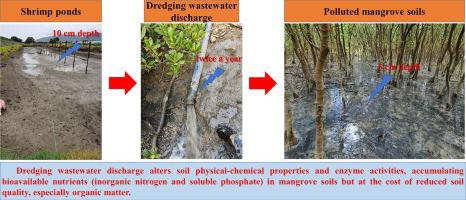当前位置:
X-MOL 学术
›
Sci. Total Environ.
›
论文详情
Our official English website, www.x-mol.net, welcomes your feedback! (Note: you will need to create a separate account there.)
Dredging wastewater discharge from shrimp ponds affects mangrove soil physical-chemical properties and enzyme activities
Science of the Total Environment ( IF 9.8 ) Pub Date : 2024-03-24 , DOI: 10.1016/j.scitotenv.2024.171916 Jiahui Chen , Chengyu Yuan , Yang Zhang , Jiajia Wu , Guangcheng Chen , Shunyang Chen , Hongyi Wu , Heng Zhu , Yong Ye
Science of the Total Environment ( IF 9.8 ) Pub Date : 2024-03-24 , DOI: 10.1016/j.scitotenv.2024.171916 Jiahui Chen , Chengyu Yuan , Yang Zhang , Jiajia Wu , Guangcheng Chen , Shunyang Chen , Hongyi Wu , Heng Zhu , Yong Ye

|
Dredging wastewater discharge is a significant environmental concern for mariculture near mangrove ecosystems. However, little attention has been paid to its effects on the soil physical-chemical properties and enzyme activities in mangrove habitats. This study compared the soil physical-chemical properties and enzyme activities in the polluted area that received dredging wastewater from a shrimp pond with those in the control area without wastewater to explore the effects of wastewater discharge on the soil physical-chemical properties and enzyme activities. Variations in soil physical-chemical properties and enzyme activities across different tidal flat areas and depths were also examined. The polluted area exhibited lower soil salinity (10.47 ± 0.58 vs. 15.64 ± 0.54) and moisture content (41.85 ± 1.03 % vs. 45.81 ± 1.06 %) than the control area. Wastewater discharge increased soil enzyme activities, (acid phosphatase, protease, and catalase), resulting in higher inorganic nitrogen (13.20 ± 0.00 μg g vs. 11.60 ± 0.03 μg g) but lower total nitrogen (0.93 ± 0.01 mg g vs. 1.62 ± 0.11 mg g) in the contaminated zone. From the control to polluted area, there was an approximate increase of 0.43 and 0.83 mg g in soil total phosphorus and soluble phosphate, driven by increased acid phosphatase. However, soil humus and organic matter decreased by 0.04 and 1.22 %, respectively, because of wastewater discharge. The impact of wastewater discharge on the soil physical-chemical properties and enzyme activities was most pronounced in the landward and surface soil layers (0–5 cm). The results showed that wastewater discharge altered soil physical-chemical properties and enzyme activities, accumulating soil bioavailable nutrients (inorganic nitrogen and soluble phosphate), but at the cost of reduced soil quality, especially organic matter, further adversely affecting the overall health of mangrove ecosystems. Prioritizing the management of wastewater discharged from mariculture adjacent to mangrove forests is crucial for mangrove conservation.
中文翻译:

虾塘疏浚废水排放对红树林土壤理化性质及酶活性的影响
疏浚废水排放是红树林生态系统附近海水养殖的一个重要环境问题。然而,其对红树林生境土壤理化性质和酶活性的影响却很少受到关注。本研究比较了接受虾塘疏浚废水的污染区与无废水对照区的土壤理化性质和酶活性,探讨废水排放对土壤理化性质和酶活性的影响。还检查了不同滩涂区域和深度的土壤理化性质和酶活性的变化。污染区的土壤盐分(10.47±0.58 vs. 15.64±0.54)和水分含量(41.85±1.03% vs. 45.81±1.06%)均低于对照区。废水排放增加了土壤酶活性(酸性磷酸酶、蛋白酶和过氧化氢酶),导致无机氮含量较高(13.20 ± 0.00 µg g vs. 11.60 ± 0.03 µg g),但总氮较低(0.93 ± 0.01 mg g vs. 1.62 ± 0.11 mg g)在污染区。从对照区到污染区,在酸性磷酸酶增加的驱动下,土壤全磷和可溶性磷酸盐大约增加了0.43和0.83 mg·g。然而,由于废水排放,土壤腐殖质和有机质分别减少了0.04%和1.22%。废水排放对土壤理化性质和酶活性的影响在向陆和表土层(0-5 cm)最为明显。结果表明,废水排放改变了土壤理化性质和酶活性,积累了土壤生物可利用养分(无机氮和可溶性磷酸盐),但代价是土壤质量特别是有机质下降,进一步对红树林生态系统的整体健康产生不利影响。优先管理红树林附近海水养殖排放的废水对于红树林保护至关重要。
更新日期:2024-03-24
中文翻译:

虾塘疏浚废水排放对红树林土壤理化性质及酶活性的影响
疏浚废水排放是红树林生态系统附近海水养殖的一个重要环境问题。然而,其对红树林生境土壤理化性质和酶活性的影响却很少受到关注。本研究比较了接受虾塘疏浚废水的污染区与无废水对照区的土壤理化性质和酶活性,探讨废水排放对土壤理化性质和酶活性的影响。还检查了不同滩涂区域和深度的土壤理化性质和酶活性的变化。污染区的土壤盐分(10.47±0.58 vs. 15.64±0.54)和水分含量(41.85±1.03% vs. 45.81±1.06%)均低于对照区。废水排放增加了土壤酶活性(酸性磷酸酶、蛋白酶和过氧化氢酶),导致无机氮含量较高(13.20 ± 0.00 µg g vs. 11.60 ± 0.03 µg g),但总氮较低(0.93 ± 0.01 mg g vs. 1.62 ± 0.11 mg g)在污染区。从对照区到污染区,在酸性磷酸酶增加的驱动下,土壤全磷和可溶性磷酸盐大约增加了0.43和0.83 mg·g。然而,由于废水排放,土壤腐殖质和有机质分别减少了0.04%和1.22%。废水排放对土壤理化性质和酶活性的影响在向陆和表土层(0-5 cm)最为明显。结果表明,废水排放改变了土壤理化性质和酶活性,积累了土壤生物可利用养分(无机氮和可溶性磷酸盐),但代价是土壤质量特别是有机质下降,进一步对红树林生态系统的整体健康产生不利影响。优先管理红树林附近海水养殖排放的废水对于红树林保护至关重要。



























 京公网安备 11010802027423号
京公网安备 11010802027423号